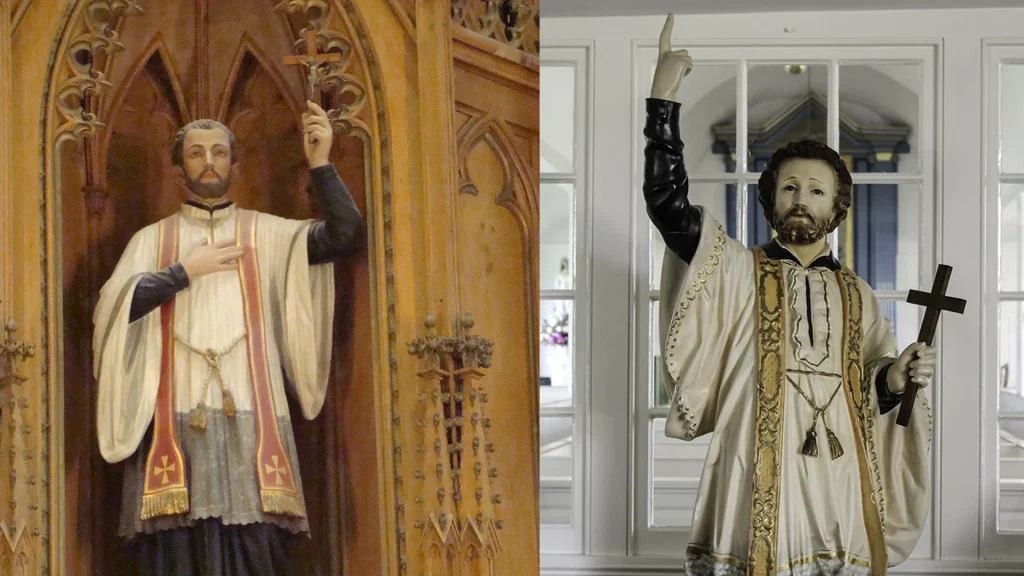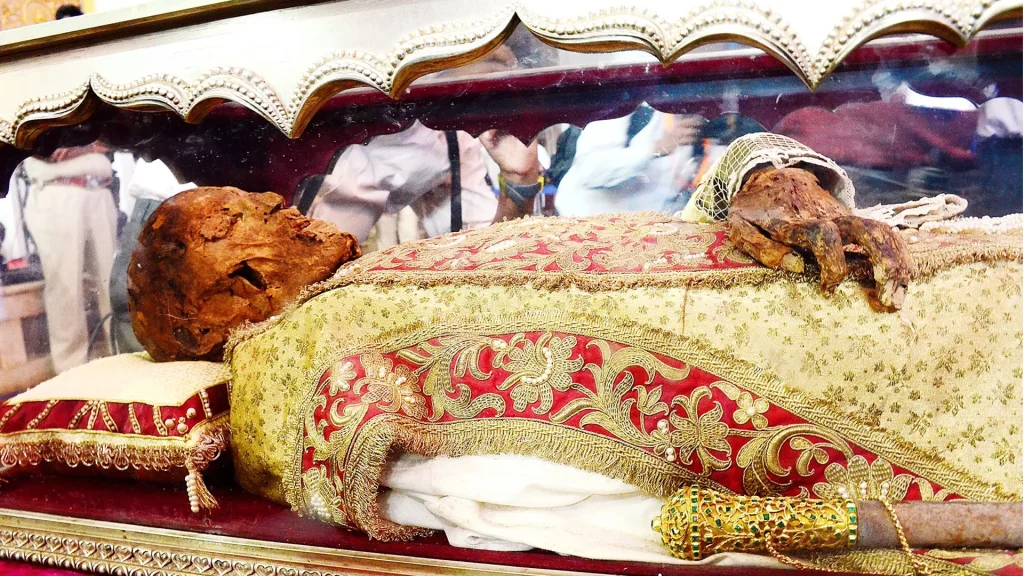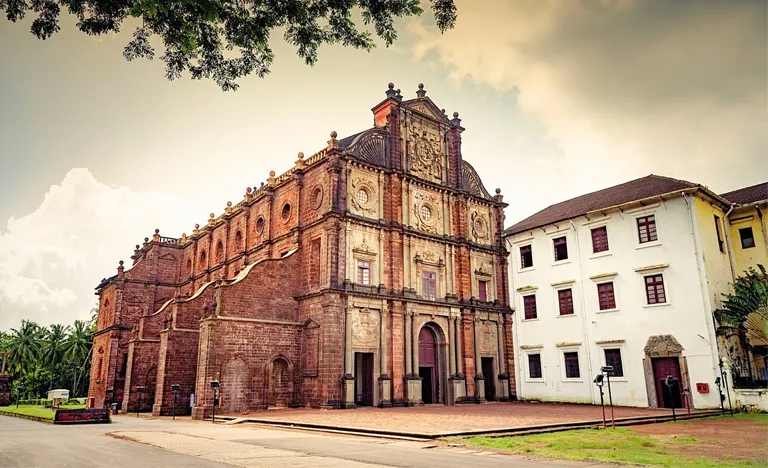
Introduction
The Basilica of Bom Jesus or Borea Jezuchi Bajilika is located in Goa, India, and is a UNESCO World Heritage Site. The basilica holds the mortal remains of St. Francis Xavier.
10 km east of Panaji, along the Mandovi river, is the town of Old Goa, where lie some of India’s greatest churches and among them, the most popular and the most revered by Christians worldwide is the Basilica of Bom Jesus. The Basilica, dedicated to Infant Jesus, has been declared a World Heritage Monument now. ‘Bom Jesus’ means ‘Infant Jesus’ or ‘Good Jesus’. Renowned throughout the Catholic world, the 16th century cathedral is India’s first Minor Basilica, and is considered as one of the best examples of baroque architecture in India.
The layout follows simple Renaissance norms while the detailing and decoration is unabashed Baroque. It’s an opulent structure which incorporates white marble and has beautifully gilded altars decorated with frescoes and inlay work. The Basilica houses the sacred relics of St. Francis Xavier, patron saint of Goa who died in 1552. The mortal remains of the saint were gifted to the church by Cosimo de Medici III, Grand Duke of Tuscany.
Today, the embalmed body lies in an airtight glass coffin positioned in a silver casket crafted by a 17th century Florentine sculptor, Giovanni Batista Foggini. In accordance with his wishes, his remains were transferred to Goa the following year after his death. It is said that, while transferring, the saint’s body was found to be as fresh as the day it was buried. This miraculous phenomenon continues to attract the devout from all lands, and an ‘Exposition’ or public viewing of his body happens, once every decade, to allow pilgrims to view it.
The saint is believed to have miraculous powers of healing, and pilgrims come from all over the world to offer prayers. The silver casket is lowered for public viewing only during the public exposition. The Last Exposition was in 2014 and will be open again in 2024. Intricately carved basalt embellishments make it one of the richest facades in Goa. The layout follows simple Renaissance norms while the detailing and decoration is unabashed Baroque. The mausoleum of St. Xavier is a marvel of Italian art (the marble base) and Hindu craftsmanship (the silver casket).
The elaborately gilded altars are beautiful examples of sculptures and carvings in wood, stone, gold and granite. Columns are covered with marble and inlaid with precious stones. The church also houses paintings depicting the life of St. Francis Xavier. Visitors are overcome by the deep spirituality and tranquility of the place. Every year thousands of people visit the cathedral especially in December. A trip to Goa is incomplete without a visit to the revered Basilica.
History, Construction and Architecture

The Basilica of Bom Jesus is a monument typical of the classic forms of plane architecture, introduced by the Society of Jesus, otherwise known as the Jesuits. The façade, which is of granite, represents features of five styles of architecture: Roman, Ionic, Doric, Corinthian and Composite. It is a large single Nave structure built ( 1595-1605) and paid for with legacies left by Dom Jeronimo Mascarenhas, a wealthy Portuguese Captain of Cochin.
It is the only monument with a façade not covered with plaster. The plaster was stripped off in 1970 by an over-zealous Portuguese conservationist who believed that this would help preserve the carvings on the façade better. Unfortunately, even though this was soon seen to be a false assumption, no one has put the plaster back.
The foundation stone for this church was laid on the 24th of November, 1594. Archbishop Rev. Fr. Aleixo de Menezes consecrated the church, on its completion on the 15th of May 1605. However, it was only raised to the status of “minor Basilica” in 1946.
The three-storied structure stands 75ft wide and 78½ft tall. The façade of the church, though un-plastered, is a magnificent example of baroque architecture. It combines elements of Doric, Ionic and Corinthian design, and is divided into four parts.
The lowest section has three doors set into it, a large one in the middle with two smaller ones flanking it. The second section has three square windows whose positioning corresponds to that of the doors. The third section has three circular windows whilst the last section forms a quadrangle, lavishly decorated with arabesque. This quadrangular pediment also has “IHS” carved into it. This is the Jesuit emblem and stands for “Iesus Hominum Salvator”, which is Latin for, “Jesus, Saviour of Men”. All the sections have carved basalt pillars. The basalt was mined from Bassein in the North of Goa.
Interior and Artwork

The interior of the church is a study in contrasts. The design in itself is simple, but the floor is laid with the finest marble, and was inlaid with precious stones. The altar is elaborately carved and gilded.
The retable of the main altar exhibits a huge statue of Saint Ignatius of Loyola, the founder (along with St. Francis Xavier who was a founding member) of the Society of Jesus and below it, a small image of Bom Jesus (Child Jesus), the patron of the church.
On the southern side of the transept lies the Chapel of St. Francis Xavier. This chapel has carved and gilded columns and wood-carved floral decorations. This is where the relics of the saint are kept. There is a gorgeous silver statue placed in front of the silver casket where the body of St. Francis Xavier reposes.
The interior of the Basilica measures 83ft in length, 51ft in width and 61ft in height. It is laid out in the orthodox cruciform fashion with a single nave and transept. The ceiling was once vaulted, but has since been replaced with a simple wooden one. The main altar measures a massive 54ft by 30ft. The interiors, while being furnished with the best of materials show a remarkable simplicity typical of Renaissance design.
The Basilica contains two chapels, three altars, a sacristy and a choir loft. There is also a belfry at the back. The door through which one enters stands beneath the choir loft. To the right is an altar which is dedicated to St. Anthony and to the left is a well-carved statue of St. Francis Xavier. On the northern wall of the nave is the cenotaph of Dom Jeronimo Mascarenhas. He was the Captain of Cochin and his estate made possible the construction of the Basilica.
The columns which support the choir loft bear plaques inscribed in Portuguese and Latin detailing the dates of the Basilica’s construction and consecration. In the transept are two altars which flank the main one. They are highly carved and decorated and are dedicated to St. Michael and Our Lady of Good Hope.
The main altar is extremely well carved and gilded. It is backed by an ornate reredos which stretches from floor to ceiling, its baroque carvings in sharp contrast to the classically plain design of the Basilica. The reredos has within it a large statue of St. Ignatius of Loyola protecting the Infant Jesus. His eyes are raised to a carved disc, once more bearing the Jesuit emblem of “IHS”. Above this medallion is a depiction of the Holy Trinity, i.e. The Father, The Son and The Holy Spirit.
On the northern side of the transept is the Chapel of the Blessed Sacrament. On the southern side is the Chapel of St. Francis Xavier. Adjoining this chapel is a corridor leading to the sacristy, accessed by a marvellously carved wooden door. It is a vaulted wooden structure ending in an apse. In this reposes an altar which has an iron chest containing the Golden Rose which was bestowed upon the Se Cathedral by Pope Pius XII.
The walls are hung with paintings of the saints and the sacristy also contains a beautifully carved chest of drawers. Near the iron chest is a painting of the relics of St. Francis Xavier, done about 100 years ago.
Modern Art Gallery
The Basilica also contains a modern art gallery with paintings depicting various Biblical scenes. The gallery can be accessed using the stairs near the sacristy. It is one of the largest of its kind in Asia. It contains 36 paintings executed between the years 1973 and 1976. The artist was paid only for the materials used as his talent was given gratis, for the greater glory of God.
The most notable paintings are entitled “The Last Judgement” and “Genesis”
Messenger of Christ – St Francis Xavier

In 1525, having completed a preliminary course of studies in his own country, Francis Xavier went to Paris, where he entered the College of Barbara. Here he met Ignatius of Loyola, who was already planning the foundation of the Society of Jesus, and Pedro Fabro. They were instrumental in changing the attitude of Francis by dinning into his ears the famous words of Jesus: What does it profit a man to gain the whole world if he loses his soul?
He became one of the first members of the Society of Jesus and took his vows with Ignatius and five others on 15th August 1534, in a small chapel in Montmartre, to serve Jesus in poverty and chastity. After leaving Paris, Francis went, with the rest of the members of the newly papal-approved Jesuit order, to Venice to be ordained to priesthood, which took place on 24th June 1537.
The first objective of Ignatius and his companions had been to make a pilgrimage to Jerusalem. While waiting in Venice, Italy, to depart for the Holy Land, Xavier worked in a hospital, aiding those in need. When fighting between Venice and the Ottoman Empire made a trip to Jerusalem impossible, Xavier instead went to Rome, where he and others in the society offered their services to the Pope. They presented themselves to the Pope to go anywhere and to always be at his disposal.
Tomb of St. Francis Xavier

Fr. Francis Xavier died of a fever in 1552 on the island of Shangchaun, whilst waiting for a boat to travel to China. His last rites were performed and he was laid to rest in a simple coffin in the Portuguese colony of Malacca. When his remains were disinterred some years later, they were found to be “fresh and intact”. Upon hearing of this, the Vatican canonized him a saint. His remains were buried in three different places before they came to their final resting place in Goa.
The arrangements of keeping the body of St Francis Xavier in the Chapel were completed on 24th April 1659. The mausoleum, in Florentine style, was the offer of the last of the Medici’s, Cosimo III, Duke of Tuscany. It is a masterpiece setting and was made by Giovanni Batista Foggini and assembled in Goa by Placido Francesco Ramponi.
The silver casket is made up of silver panels which depict 32 scenes from the life of the saint. These panels were created for this purpose by Goan silversmiths under the supervision of Fr. Marco Mastrilli SJ.
Professed House
The construction of the Professed house, which lies next door to the Basilica, began in 1585 and so predates the Basilica by a few years. It is a two-storied building, built of laterite rock and covered with lime plaster. Its construction was completed in 1589 under the aegis of Br. Domingos Fernandes.
This became the mission centre for all Jesuit missions to the eastern regions of the known world. The “Casa Professa”, according to Jesuit canon, was intended for the exercise of the Ministries of the Society of Jesus, and should be conspicuous for its exact adherence to the Jesuit way of life.
Legend and Lore
The legend has it that the Jesuits who wanted to construct the Professed House and later the Basilica met with stiff opposition from the Portuguese administration. They had a house on the property, but were being denied permission to build the church. On the eve of the day when they were to be evicted, the wily priests converted the house into a make-shift church, painting the word “Jesus” on the door and putting up a bell. The next morning the bell was rung, much to the surprise of the inhabitants of the surrounding areas, to call them for Mass. After that, the Portuguese were never able to evict the Jesuits from this place.
Another interesting tale from the history of this Basilica is that the Duke of Tuscany, who sponsored the building of the mausoleum of St. Francis Xavier, did so out of gratitude. He had been presented with the pillow upon which the saint’s head had been resting by the Jesuit Procurator General of Goa. He felt that such a great saint deserved a grander resting place.
Many stories have originated around the relics of St. Francis Xavier. Some believers claim that his body shrinks every year, and when it shrinks to nothing, it will signify the end of the world. Others tell a tale of a woman, who whilst bending to kiss his feet in devotion bit off his big toe. They say that though the toe was bitten off a corpse it yet bled and so she was caught out and the toe returned to the rest of the relics.
Simple yet regal, austere yet opulent, unassuming yet grand, this Basilica has risen from its humble beginnings into a world famous monument that commands respect and worship from religious pilgrims and architectural buffs alike. The atmosphere of the Basilica is cool, calm and majestic. The awe-inspiring feeling of being in the presence of something much greater than oneself is a truly humbling experience.
Feast Day - 3rd December
Annual Feast Day of St. Francis Xavier held on 3rd December.
Each year, on 3rd December, marks the anniversary of St Francis Xavier’s death, when thousands gather at the Basilica of Bom Jesus. This annual festival, known as the Feast of St Francis Xavier or Goinchea Saibache Fest, (Lord of Goa Festival), is the biggest of all the Christian festivals in Goa.
Mass Time
Week Days
- 7:00 am (Konkani)
- 8:00 am (Konkani)
- 6:00 pm (Konkani)
- 5:00 pm (Konkani – Only on 1st Friday of the month – Holy Hour followed by mass)
Saturdays
- 7:00 am (Konkani)
- 8:00 am (Konkani)
- 6:00 pm (Konkani)
Sundays
- 8:00 am (Konkani)
- 9:15 am (Konkani)
- 10:15 am (English)
- 6:00 pm (Konkani)
Contact Info:
Old Goa Road, Bainguinim,
Goa – 403402, India
Phone No.
Accommodations
Connectivity
Basilica of Bom Jesus is well connected Bus Station, Railway Station and Airport facilities rest of the country.
Airways
The nearest airport is Goa Airport (26.8 Kms) from Basilica of Bom Jesus.
Railways
The nearest railway station is Madgoan Junction (Goa) which is (33 kms) from Basilica of Bom Jesus.
Roadways
The nearest Goa Bus Station is (49.5 Kms) from Basilica of Bom Jesus.








